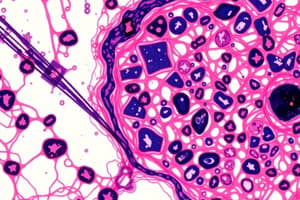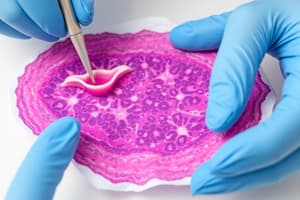Podcast
Questions and Answers
What is the primary purpose of electroplating?
What is the primary purpose of electroplating?
Which process shares similarities with anodizing?
Which process shares similarities with anodizing?
What is a potential outcome of using laser polishing on metallic components?
What is a potential outcome of using laser polishing on metallic components?
Why is post-processing important in manufacturing?
Why is post-processing important in manufacturing?
Signup and view all the answers
Which of the following is NOT considered a major post-processing technique to remove defects?
Which of the following is NOT considered a major post-processing technique to remove defects?
Signup and view all the answers
What defect is commonly associated with metal additive manufacturing?
What defect is commonly associated with metal additive manufacturing?
Signup and view all the answers
What is one of the solutions for addressing defects in metal additive manufacturing?
What is one of the solutions for addressing defects in metal additive manufacturing?
Signup and view all the answers
Which statement best describes laser polishing?
Which statement best describes laser polishing?
Signup and view all the answers
What is the primary focus of in-out and out-in scanning strategies in powder bed-based AM methods?
What is the primary focus of in-out and out-in scanning strategies in powder bed-based AM methods?
Signup and view all the answers
Which particle properties directly influence flowability in additive manufacturing?
Which particle properties directly influence flowability in additive manufacturing?
Signup and view all the answers
How does decreasing particle size affect electrostatic interactions in powder systems?
How does decreasing particle size affect electrostatic interactions in powder systems?
Signup and view all the answers
What characteristics contribute to better flow in a powder system?
What characteristics contribute to better flow in a powder system?
Signup and view all the answers
What is a consequence of using coarser particles with uniform sizes in a powder bed?
What is a consequence of using coarser particles with uniform sizes in a powder bed?
Signup and view all the answers
What particle size range is preferred for powder bed-based systems?
What particle size range is preferred for powder bed-based systems?
Signup and view all the answers
What does an increase in blade energy during powder flow testing indicate?
What does an increase in blade energy during powder flow testing indicate?
Signup and view all the answers
Which factor is crucial for ensuring good layer density in powder systems?
Which factor is crucial for ensuring good layer density in powder systems?
Signup and view all the answers
What determines the maximum layer thickness in a melt pool?
What determines the maximum layer thickness in a melt pool?
Signup and view all the answers
Which factors influence the choice of layer thickness for the BJ process?
Which factors influence the choice of layer thickness for the BJ process?
Signup and view all the answers
How does build chamber temperature affect printed components?
How does build chamber temperature affect printed components?
Signup and view all the answers
What is a consequence of having low powder bed temperature and high power?
What is a consequence of having low powder bed temperature and high power?
Signup and view all the answers
What effect might increasing the powder bed temperature have?
What effect might increasing the powder bed temperature have?
Signup and view all the answers
Which of the following is crucial for monitoring ambient characteristics during metal processing?
Which of the following is crucial for monitoring ambient characteristics during metal processing?
Signup and view all the answers
What happens to printed components with a high powder bed temperature gradient?
What happens to printed components with a high powder bed temperature gradient?
Signup and view all the answers
What equipment is essential for in-situ monitoring of the powder bed temperature profile?
What equipment is essential for in-situ monitoring of the powder bed temperature profile?
Signup and view all the answers
What can cause the instability of the melt pool in additive manufacturing?
What can cause the instability of the melt pool in additive manufacturing?
Signup and view all the answers
How do trapped gas pores primarily form during the additive manufacturing process?
How do trapped gas pores primarily form during the additive manufacturing process?
Signup and view all the answers
What is the significance of optimizing parameters in additive manufacturing?
What is the significance of optimizing parameters in additive manufacturing?
Signup and view all the answers
What relationship describes the microhardness of AM-processed alloys?
What relationship describes the microhardness of AM-processed alloys?
Signup and view all the answers
How does the thermal history of layers in AM affect their hardness?
How does the thermal history of layers in AM affect their hardness?
Signup and view all the answers
What happens to micro-hardness in multilayer deposited steels during the additive manufacturing process?
What happens to micro-hardness in multilayer deposited steels during the additive manufacturing process?
Signup and view all the answers
Which factor primarily influences the hardness of AM-processed ferrous alloys?
Which factor primarily influences the hardness of AM-processed ferrous alloys?
Signup and view all the answers
What is a consequence of the liquid melt’s time-dependent cooling rate in AM?
What is a consequence of the liquid melt’s time-dependent cooling rate in AM?
Signup and view all the answers
What is the primary function of support structures in additive manufacturing?
What is the primary function of support structures in additive manufacturing?
Signup and view all the answers
Which of the following describes the importance of density in additive manufacturing?
Which of the following describes the importance of density in additive manufacturing?
Signup and view all the answers
What affects the density of AM parts during production?
What affects the density of AM parts during production?
Signup and view all the answers
Which type of support structure is characterized by a high density?
Which type of support structure is characterized by a high density?
Signup and view all the answers
What is one of the common defects found in AM printed alloys?
What is one of the common defects found in AM printed alloys?
Signup and view all the answers
How do support structures in Powder Bed Fusion (PBF) processes contribute to print quality?
How do support structures in Powder Bed Fusion (PBF) processes contribute to print quality?
Signup and view all the answers
What parameter is crucial for optimizing the mechanical properties of AM printed parts, especially for critical applications?
What parameter is crucial for optimizing the mechanical properties of AM printed parts, especially for critical applications?
Signup and view all the answers
What effect does insufficient energy flux have on additive manufacturing?
What effect does insufficient energy flux have on additive manufacturing?
Signup and view all the answers
Study Notes
AM Processing
- Printing defects can be reduced through post processing
- Common post processing techniques:
- Electropolishing
- Anodizing
- Laser polishing
- Post processing is important for removing defects from metal printed parts and improving their surface finish
- Defects in metal printed parts can be caused by many factors:
- Poor powder flow
- Incorrect laser settings
- Improper build chamber temperature
- Scanning patterns in AM:
- In-out scanning
- Out-in scanning
- Spiral scanning
- Powder bed-based AM methods use powdered materials for printing
- Powder properties affect print quality:
- Particle size distribution
- Sphericity
- Surface roughness
- Cohesive powder reduces flowability
- Powder flowability affects print quality
- Particle size range should be large enough for smaller particles to fill gaps between coarser particles and improve layer density
- Particle size range should not be too wide, as this can limit flowability
- Powder bed-based systems prefer a particle size smaller than 100 µm
- Build chamber temperature significantly affects printed parts
- Temperature, in conjunction with beam power, affect melt pool size and type
- High powder bed temperature gradient can cause crack formation
- Sensors like infrared cameras and thermocouples are necessary for in-situ monitoring of the powder bed temperature profile
- Supporting structures are necessary in some AM processes for providing thermal stability and preventing part distortion
- Density and dispersion of supporting structures significantly affect print quality
- Several AM processes exist, each with unique process parameters that affect print quality
Mechanical Properties of AM Printed Parts
- Density above 99.5% is a priority for AM-made parts in critical applications
- AM-made parts now have mechanical properties comparable to conventionally made parts
- Porosity affects cracking and mechanical properties
- AM product density depends on the energy volume given to the material
- Insufficient energy flux can cause unmelted material, resulting in irregular voids that reduce density
- Excessive energy input may cause melt pool dynamic instability, which may lead to a keyhole mode that decreases density due to trapped gas pores
- Optimizing parameters to maximize density by reducing porosities is crucial to improving part quality
- Optimizing parameters to maximize density by reducing porosities is done because pore size and distribution affect mechanical properties
- Hardness is a measure of a material's resistance to indentation
- The microhardness of AM-processed alloys follows the Hall-Petch relationship
- The microstructure coarsens with a larger cross-sectional area causing the hardness to drop
- The thermal history of each layer affects its hardness
- Using different process parameters for the cross-sectional area may improve hardness heterogeneity
- The development of hardness in AM-processed ferrous alloys is influenced by process input parameters
- In multilayer deposited steels, microhardness drops from the initially deposited layers and then increases
- This inconsistency is due to the liquid melt's time-dependent cooling rate and the middle area's slow solidification rate
- Top and bottom AM parts have higher hardness than the middle
- In low alloy steels, such as 41XX series steels, alloying components and carbon effect phase formation and hardness
- Tensile strength and static strength refers to a material's ability to withstand tensile stress without failing
- Fatigue behavior refers to a material's ability to withstand repeated loading cycles without failing
- Common defects in AM printed parts include porosity, cracking, and surface roughness
- These defects can significantly affect the mechanical properties of AM printed parts
Studying That Suits You
Use AI to generate personalized quizzes and flashcards to suit your learning preferences.
Related Documents
Description
This quiz explores various post processing techniques used in additive manufacturing to reduce printing defects. Learn about common methods like electropolishing and anodizing, the impact of powder properties on print quality, and the importance of scanning patterns. It is essential for improving the surface finish of metal printed parts.




